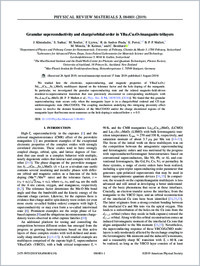Granular superconductivity and charge/orbital order in YBa 2 Cu 3 O 7 /manganite trilayers
- Khmaladze, Jarji Department of Physics and Fribourg Center for Nanomaterials, University of Fribourg, Switzerland
- Sarkar, Subhrangsu Department of Physics and Fribourg Center for Nanomaterials, University of Fribourg, Switzerland
- Soulier, Mathias Department of Physics and Fribourg Center for Nanomaterials, University of Fribourg, Switzerland
- Lyzwa, Fryderyk Department of Physics and Fribourg Center for Nanomaterials, University of Fribourg, Switzerland
- Prada, R. de Andres Department of Physics and Fribourg Center for Nanomaterials, University of Fribourg, Switzerland
- Perret, Edith Department of Physics and Fribourg Center for Nanomaterials, University of Fribourg, Switzerland - Laboratory for Advanced Fibers, Empa, Swiss Federal Laboratories for Materials Science and Technology, St. Gallen, Switzerland
- Mallett, Benjamin P. P. The MacDiarmid Institute and the Dodd Walls Centre for Photonic and Quantum Technologies, Photon Factory, University of Auckland, New Zealand
- Minola, M. Max-Planck-Institut für Festkörperforschung, Stuttgart, Germany
- Keimer, B. Max-Planck-Institut für Festkörperforschung, Stuttgart, Germany
- Bernhard, Christian Department of Physics and Fribourg Center for Nanomaterials, University of Fribourg, Switzerland
-
01.08.2019
Published in:
- Physical Review Materials. - 2019, vol. 3, no. 8, p. 084801
English
We studied how the electronic, superconducting, and magnetic properties of YBa2Cu3O7/Nd1−x(Ca1−ySry )xMnO3 multilayers depend on the tolerance factor and the hole doping of the manganite. In particular, we investigated the granular superconducting state and the related magnetic-field-driven insulator-to- superconductor transition that was previously discovered in corresponding multilayers with Pr0.5La0.2Ca0.3MnO3 [B. P. P. Mallett et al., Phys. Rev. B 94, 180503(R) (2016)]. We found that this granular uperconducting state occurs only when the manganite layer is in a charge/orbital ordered and CE-type antiferromagnetic state (Mn-CO/OO). The coupling mechanism underlying this intriguing proximity effect seems to involve the domain boundaries of the Mn-CO/OO and/or the charge disordered regions of the manganite layer that become more numerous as the hole doping is reduced below x = 0.5.
- Faculty
- Faculté des sciences et de médecine
- Department
- Département de Physique
- Language
-
- English
- Classification
- Physics
- License
-
License undefined
- Identifiers
-
- RERO DOC 327008
- DOI 10.1103/PhysRevMaterials.3.084801
- Persistent URL
- https://folia.unifr.ch/unifr/documents/308043
Other files
Statistics
Document views: 147
File downloads:
- pdf: 182
- Supplementary material: 123

